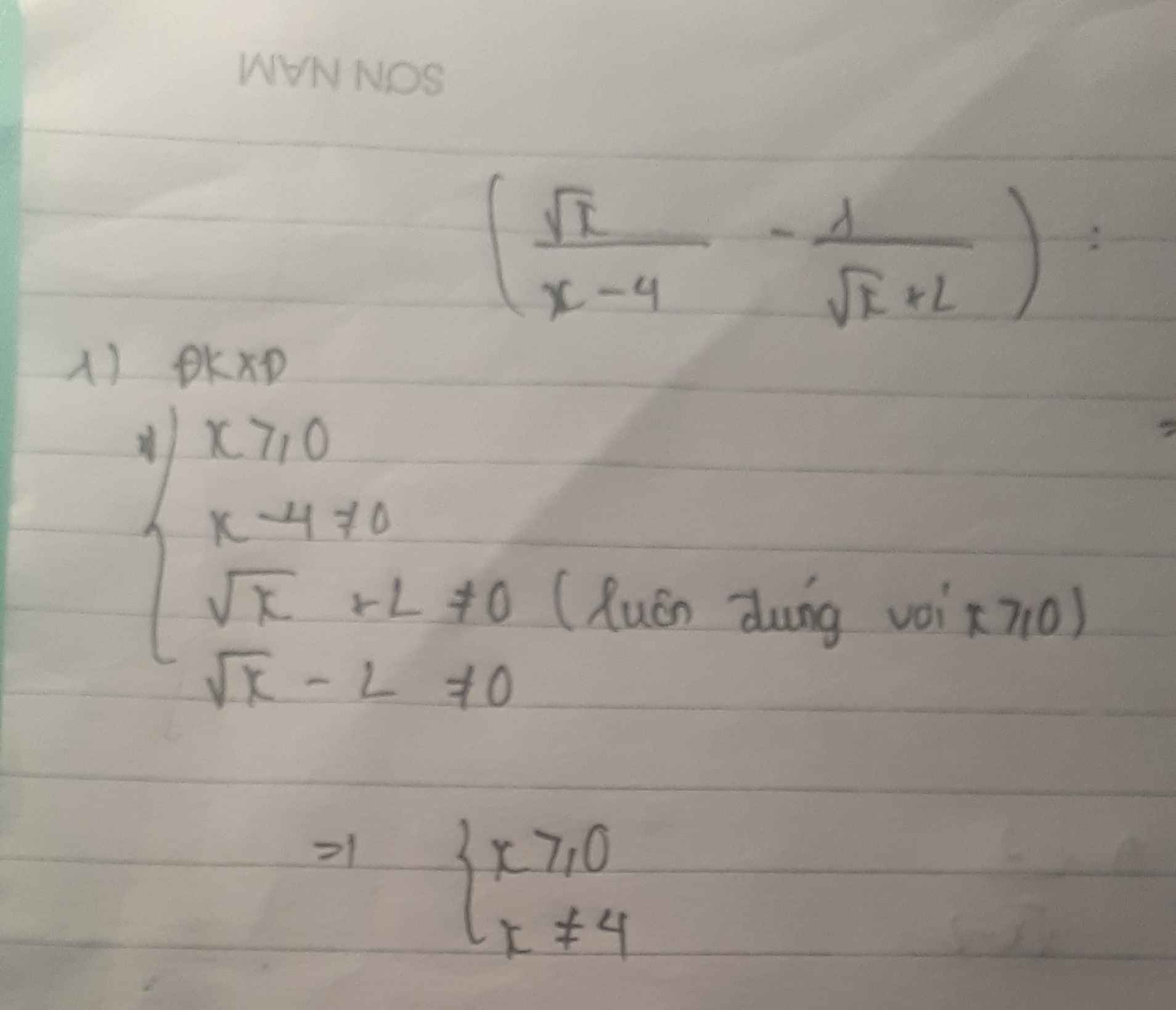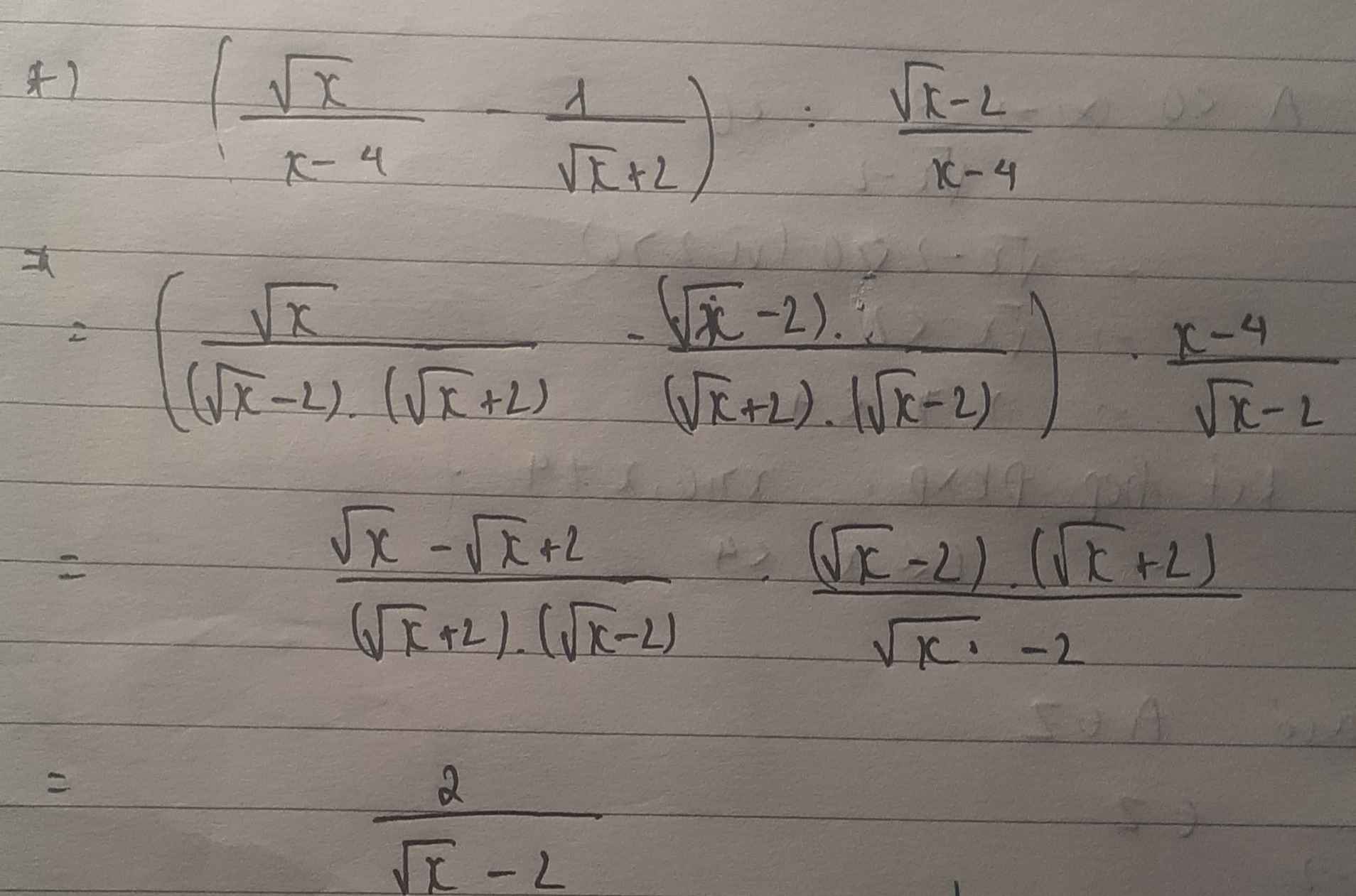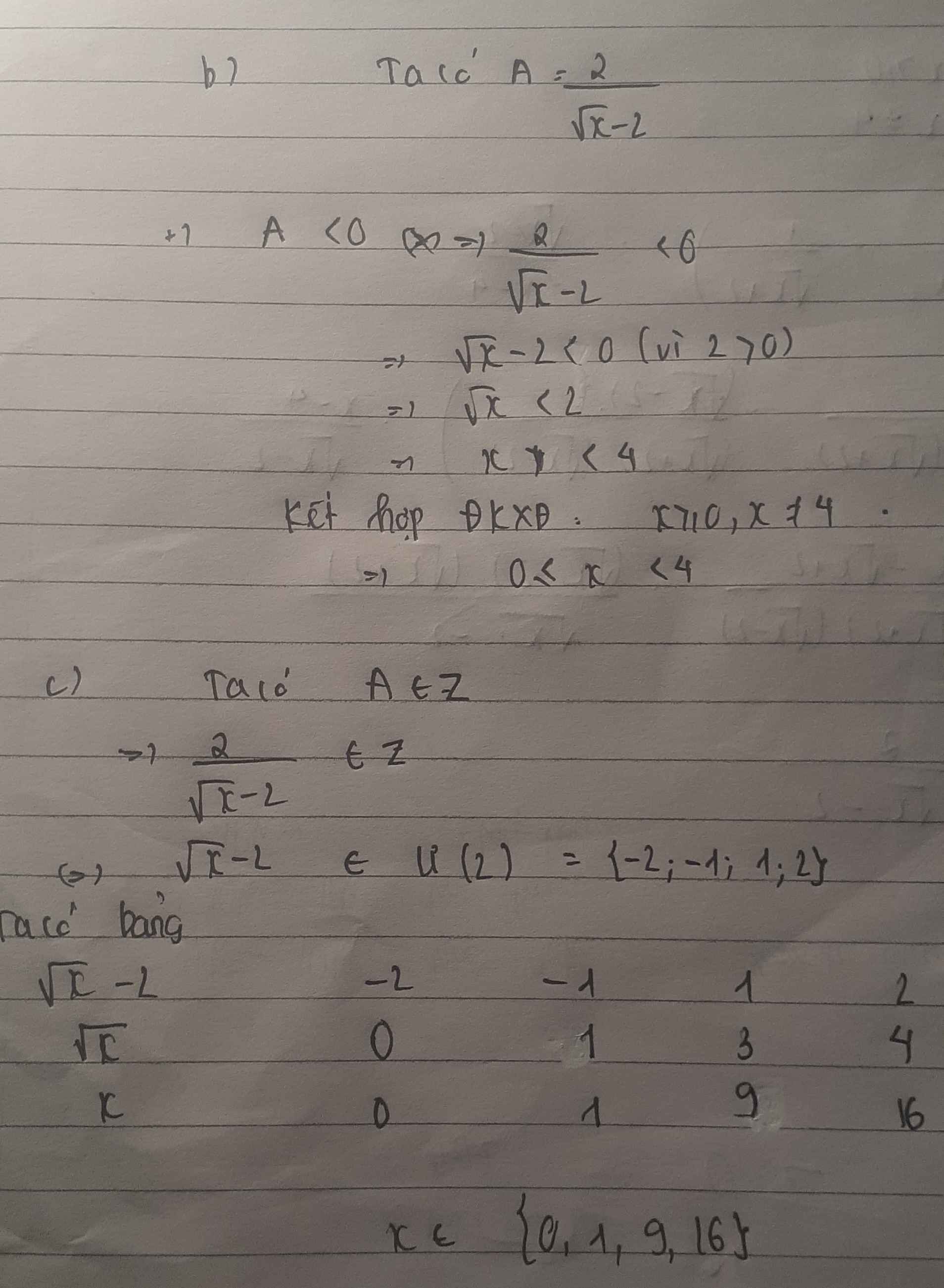Hãy nhập câu hỏi của bạn vào đây, nếu là tài khoản VIP, bạn sẽ được ưu tiên trả lời.


a) \(ĐKXĐ:\hept{\begin{cases}x\ge0\\x\ne25\end{cases}}\)
\(A=\frac{x+3\sqrt{x}}{x-25}+\frac{1}{\sqrt{x}+5}\)
\(=\frac{x+3\sqrt{x}+\sqrt{x}-5}{\left(\sqrt{x}+5\right)\left(\sqrt{x}-5\right)}\)
\(=\frac{x+4\sqrt{x}-5}{\left(\sqrt{x}+5\right)\left(\sqrt{x}-5\right)}\)
\(=\frac{\sqrt{x}-1}{\sqrt{x}-5}\)
\(\Rightarrow P=\frac{\sqrt{x}-1}{\sqrt{x}-5}:\frac{\sqrt{x}+2}{\sqrt{x}-5}=\frac{\sqrt{x}-1}{\sqrt{x}+2}\)
b) Để P nguyên
\(\Leftrightarrow\sqrt{x}-1⋮\sqrt{x}+2\)
\(\Leftrightarrow3⋮\sqrt{x}+2\)
\(\Leftrightarrow\sqrt{x}+2\inƯ\left(3\right)=\left\{\pm1;\pm3\right\}\)
\(\Leftrightarrow\sqrt{x}\in\left\{-3;-1;-5;1\right\}\)
Mà \(\sqrt{x}\ge0,\forall x\)
\(\Leftrightarrow\sqrt{x}=1\)
\(\Leftrightarrow x=1\)
Vậy để P nguyên \(\Leftrightarrow x=1\)

a) Ta có: \(M=\dfrac{8x+1}{4x-5}=\dfrac{8x-10+11}{4x-5}=\dfrac{2\left(x-5\right)+11}{4x-5}=2+\dfrac{11}{4x-5}\)
Để M nhận giá trị nguyên thì \(2+\dfrac{11}{4x-5}\) nhận giá trị nguyên
\(\Rightarrow\dfrac{11}{4x-5}\) nhận giá trị nguyên
\(\Rightarrow11⋮4x-5\)
Vì \(x\in Z\) nên \(4x-5\in Z\)
\(\Rightarrow4x-5\inƯ\left(11\right)=\left\{\pm1;\pm11\right\}\)
\(\Rightarrow x\in\left\{1;\pm1,5;4\right\}\)
Vậy \(x\in\left\{1;4\right\}\) thỏa mãn \(x\in Z\).
b) Ta có: \(A=\dfrac{5}{4-x}\). ĐK: \(x\ne4\)
Nếu 4 - x < 0 thì x > 4 \(\Rightarrow A>0\)
4 - x > 0 thì x < 4 \(\Rightarrow A< 0\)
Để A đạt GTLN thì 4 - x là số nguyên dương nhỏ nhất
\(\Rightarrow4-x=1\Rightarrow x=3\)
\(\Rightarrow A=\dfrac{5}{4-3}=5\)
Vậy MaxA = 5 tại x = 3
c) \(B=\dfrac{8-x}{x-3}\). ĐK: \(x\ne3\).
Ta có: \(B=\dfrac{8-x}{x-3}=\dfrac{-\left(x-8\right)}{x-3}=\dfrac{-\left(x-3\right)+5}{x-3}=\dfrac{5}{x-3}-1\)
Để B đạt giá trị nhỏ nhất thì \(\dfrac{5}{x-3}-1\) nhỏ nhất
\(\Rightarrow\dfrac{5}{x-3}\) nhỏ nhất
Nếu x - 3 > 0 thì x > 3 \(\Rightarrow\dfrac{5}{x-3}>0\)
x - 3 < 0 thì x < 3 \(\Rightarrow\dfrac{5}{x-3}< 0\)
Để \(\dfrac{5}{x-3}\) nhỏ nhất thì x - 3 là số nguyên âm lớn nhất
\(\Rightarrow x-3=-1\Rightarrow x=2\)
\(\Rightarrow B=\dfrac{8-2}{2-3}=-6\)
Vậy MaxB = -6 tại x = 2.
Mình làm sai câu a...
Ta có: \(M=\dfrac{8x+1}{4x-1}=\dfrac{8x-2+3}{4x-1}=\dfrac{2\left(4x-1\right)+3}{4x-1}=2+\dfrac{3}{4x-1}\)
Để M nhận giá trị nguyên thì \(2+\dfrac{3}{4x-1}\) nhận giá trị nguyên
\(\Rightarrow\dfrac{3}{4x-1}\) nhận giá trị nguyên
Vì \(4x-1\in Z\) nên \(4x-1\inƯ\left(3\right)=\left\{\pm1;\pm3\right\}\)
\(\Rightarrow x\in\left\{\pm0,5;0;1\right\}\)
Vậy \(x\in\left\{0;1\right\}\) thỏa mãn \(x\in Z\).

a) Ta có: A = \(\frac{x+1}{x-2}+\frac{x-1}{x+2}+\frac{x^2+4x}{4-x^2}\)
A = \(\frac{\left(x+1\right)\left(x+2\right)}{\left(x-2\right)\left(x+2\right)}+\frac{\left(x-1\right)\left(x-2\right)}{\left(x+2\right)\left(x-2\right)}-\frac{x^2+4x}{\left(x-2\right)\left(x+2\right)}\)
A = \(\frac{x^2+3x+2+x^2-3x+2-x^2-4x}{\left(x-2\right)\left(x+2\right)}\)
A = \(\frac{x^2-4x+4}{\left(x-2\right)\left(x+2\right)}\)
A = \(\frac{\left(x-2\right)^2}{\left(x-2\right)\left(x+2\right)}=\frac{x-2}{x+2}\)
b) Với x = 4 => A = \(\frac{4-2}{4+2}=\frac{2}{8}=\frac{1}{4}\)
c) ĐKXĐ: \(\hept{\begin{cases}x-2\ne0\\x+2\ne0\\4-x^2\ne0\end{cases}}\) <=> \(\hept{\begin{cases}x\ne2\\x\ne-2\\x\ne\pm2\end{cases}}\) <=> \(x\ne\pm2\)
Ta có: A = \(\frac{x-2}{x+2}=\frac{\left(x+2\right)-4}{x+2}=1-\frac{4}{x+2}\)
Để A nhận giá trị nguyên dương <=> \(1-\frac{4}{x+2}\) nguyên dương
<=> \(-\frac{4}{x+2}\) nguyên dương <=> -4 \(⋮\)x + 2
<=> x + 2 \(\in\)Ư(-4) = {1; -1; 2; -2; 4; -4}
Lập bảng:
| x + 2 | 1 | -1 | 2 | -2 | 4 | -4 |
| x | -1(tm) | -3(tm) | 0(tm) | -4(tm) | 2(ktm) | -6(tm) |
Vậy ....

a: \(A=\left(\dfrac{x}{x^2-4}+\dfrac{4}{x-2}+\dfrac{1}{x+2}\right):\dfrac{3x+3}{x^2+2x}\)
\(=\dfrac{x+4x+8+x-2}{\left(x-2\right)\left(x+2\right)}\cdot\dfrac{x\left(x+2\right)}{3\left(x+1\right)}\)
\(=\dfrac{6\left(x+1\right)\cdot x\left(x+2\right)}{3\left(x+1\right)\left(x-2\right)\left(x+2\right)}\)
\(=\dfrac{2x}{x-2}\)

a: ĐKXĐ: \(x\notin\left\{-\dfrac{1}{2};\dfrac{1}{2};-2\right\}\)
b: \(B=\dfrac{4x^2+4x+1-4-4x^2+4x-1}{\left(2x-1\right)\left(2x+1\right)}\cdot\dfrac{2x+1}{x+2}\)
\(=\dfrac{8x-4}{2x-1}\cdot\dfrac{1}{x+2}=\dfrac{4}{x+2}\)

Bài 1 :
a, \(A=\frac{2x^2-4x+8}{x^3+8}=\frac{2\left(x^2-2x+4\right)}{\left(x+2\right)\left(x^2-2x+4\right)}=\frac{2}{x+2}\)
b, Ta có : \(\left|x\right|=2\Rightarrow\orbr{\begin{cases}x=2\\x=-2\end{cases}}\)
TH1 : Thay x = 2 vào biểu thức trên ta được :
\(\frac{2}{2+2}=\frac{2}{4}=\frac{1}{2}\)
TH2 : Thay x = -2 vào biểu thức trên ta được :
\(\frac{2}{-2+2}=\frac{2}{0}\)vô lí
c, ta có A = 2 hay \(\frac{2}{x+2}=2\)ĐK : \(x\ne-2\)
\(\Rightarrow2x+4=2\Leftrightarrow2x=-2\Leftrightarrow x=-1\)
Vậy với x = -1 thì A = 2
d, Ta có A < 0 hay \(\frac{2}{x+2}< 0\)
\(\Rightarrow x+2< 0\)do 2 > 0
\(\Leftrightarrow x< -2\)
Vậy với A < 0 thì x < -2
e, Để A nhận giá trị nguyên khi \(x+2\inƯ\left(2\right)=\left\{\pm1;\pm2\right\}\)
| x + 2 | 1 | -1 | 2 | -2 |
| x | -1 | -3 | 0 | -4 |
2.
ĐKXĐ : \(x\ne\pm2\)
a. \(B=\frac{x^2-4x+4}{x^2-4}=\frac{\left(x-2\right)^2}{\left(x-2\right)\left(x+2\right)}=\frac{x-2}{x+2}\)
b. | x - 1 | = 2 <=>\(\hept{\begin{cases}x-1=2\\x-1=-2\end{cases}}\)<=>\(\hept{\begin{cases}x=3\\x=-1\end{cases}}\)
Với x = 3 thì \(B=\frac{3-2}{3+2}=\frac{1}{5}\)
Với x = - 1 thì \(B=\frac{-1-2}{-1+2}=-3\)
Vậy với | x - 1 | = 2 thì B đạt được 2 giá trị là B = 1/5 hoặc B = - 3
c. \(B=\frac{x-2}{x+2}=-1\)<=>\(-\left(x-2\right)=x+2\)
<=> \(-x+2=x+2\)<=>\(-x=x\)<=>\(x=0\)
d. \(B=\frac{x-2}{x+2}< 1\)<=>\(x-2< x+2\)luôn đúng \(\forall\)x\(\ne\pm2\)
e. \(B=\frac{x-2}{x+2}=\frac{x+2-4}{x+2}=1-\frac{4}{x+2}\)
Để B nguyên thì 4/x+2 nguyên => x + 2\(\in\){ - 4 ; - 2 ; - 1 ; 1 ; 2 ; 4 }
=> x \(\in\){ - 6 ; - 4 ; - 3 ; - 1 ; 0 ; 2 }



ta có :
\(B=\sqrt{\frac{16x}{x+4}}=\sqrt{16-\frac{64}{x+4}}\)ta có
\(\frac{64}{x+4}\text{ nguyên khi x+4 là ước của 64}\)
\(\Rightarrow x+4\in\left\{4,8,16,32,64\right\}\Rightarrow x\in\left\{0,4,12,28,60\right\}\)
thay lại ta có các giá trị x =0 là giá trị duy nhất thỏa mãn